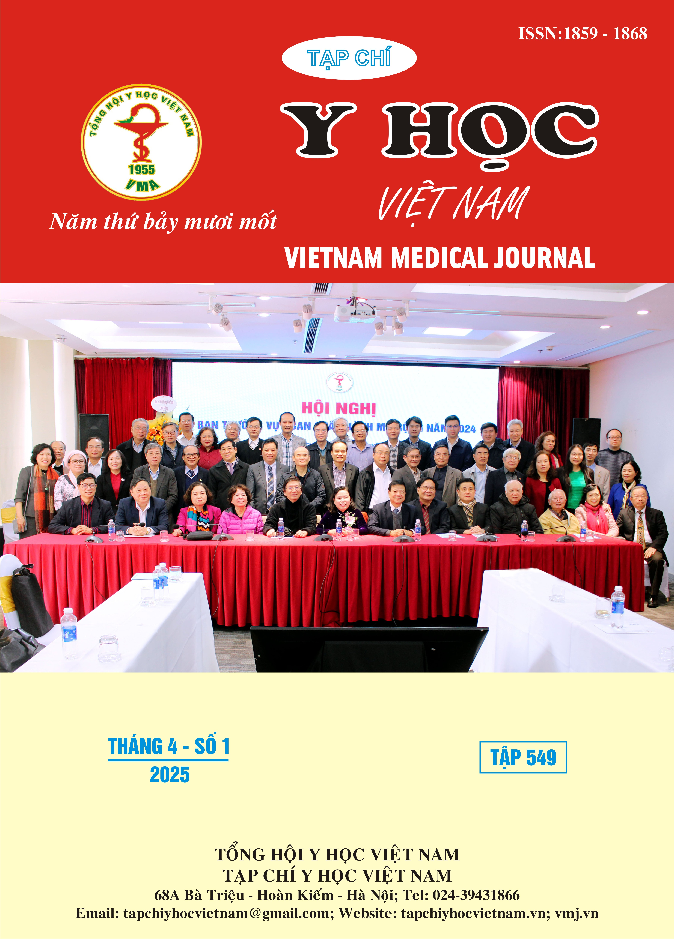SOME CLINICAL FEATURES IN PATIENTS WHO FALL AFTER STROKE TREATED AT CUADONG GENERAL HOSPITAL IN 2024 Background: To describe the clinical
Main Article Content
Abstract
Background: To describe the clinical characteristics of patients with falls after stroke treated at Cua Dong General Hospital in 2024. Objective: 55 patients with stroke including cerebral hemorrhage and cerebral infarction (with or without falls after stroke) examined and treated at Cua Dong General Hospital from February 2024 to October 2024. Method: Cross-sectional study. Results: The average age of the study group was 67.45 ± 11.08 years old, 45.45% of patients had a history of falls, of which 60% were women. 63.6% of patients were from rural areas and 87.4% of patients had cerebral infarction. Common locations of falls were next to the bed and in the bathroom. The most common time of falls was in the morning, accounting for 48%. Falls often leave mild consequences, accounting for 40%. Balance disorders account for 64% of the group of patients who fall. The group of patients with a history of falls and a high fear of falling accounts for 96% with an average FES-I score of 51.68 ± 10.88 and a risk of falling accounts for 96% with an average FRQ score of 10.24 ± 2.38. Conclusion: Patients who fall after a stroke account for 45.45%. 64% of patients who fall have balance disorders and have a fear of falling and a risk of falling accounts for 96%.
Article Details
Keywords
Stroke, risk of falling, cerebral infarction, cerebral hemorrhage
References
2. Kerse N., Parag V., Feigin V.L., et al. (2008). Falls after stroke: results from the Auckland Regional Community Stroke (ARCOS) Study, 2002 to 2003. Stroke, 39(6), 1890–1893.
3. Indredavik B., Rohweder G., Naalsund E., et al. (2008). Medical complications in a comprehensive stroke unit and an early supported discharge service. Stroke, 39(2), 414–420.
4. Morello R.T., Barker A.L., Watts J.J., et al. (2015). The extra resource burden of in-hospital falls: a cost of falls study. Med J Aust, 203(9), 367.
5. Trần Viết Lực, Nguyễn Văn Đạt, và Nguyễn Thu Hương (2024). Nghiên cứu tình hình và các yếu tố liên quan đến bệnh thần kinh ngoại biên trên người bệnh đái tháo đường típ 2 tại Bệnh viện Đa khoa tỉnh Bạc Liêu. Tạp chí Y học Việt Nam, tập 539 số 1 (2024)–271.
6. Samuelsson C.M., Hansson P.-O., and Persson C.U. (2019). Early prediction of falls after stroke: a 12-month follow-up of 490 patients in The Fall Study of Gothenburg (FallsGOT). Clin Rehabil, 33(4), 773–783.
7. Chen Y., Du H., Song M., et al. (2023). Relationship between fear of falling and fall risk among older patients with stroke: a structural equation modeling. BMC Geriatr, 23(1), 647.
8. Larén A., Odqvist A., Hansson P.-O., et al. (2018). Fear of falling in acute stroke: The Fall Study of Gothenburg (FallsGOT). Top Stroke Rehabil, 25(4), 256–260.
9. Scholz M., Haase R., Trentzsch K., et al. (2021). Fear of falling and falls in people with multiple sclerosis: A literature review. Mult Scler Relat Disord, 47, 102609.


